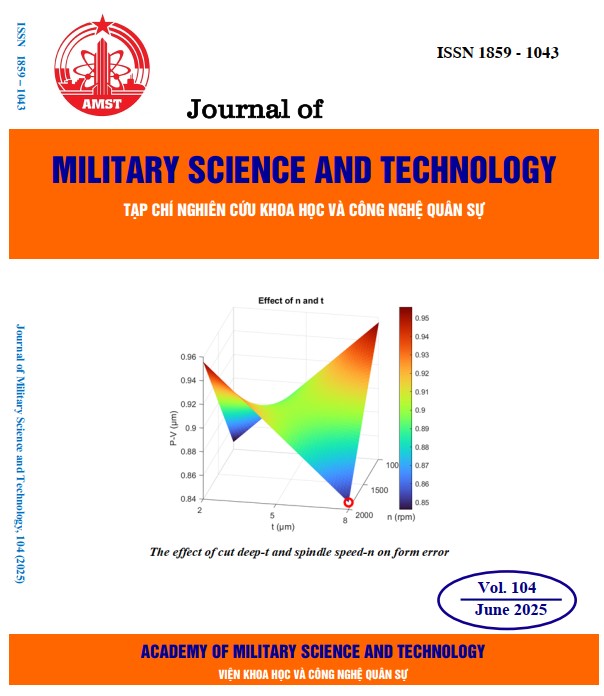Synthesis of phosphate-based binders from aluminum slag for heat-resistant inorganic coatings
335 viewsDOI:
https://doi.org/10.54939/1859-1043.j.mst.104.2025.87-93Keywords:
Aluminium slag; Poly aluminium phosphate; Inorganic binder; Waste valorization; FTIR analysis; Viscosity.Abstract
This study presents the synthesis and optimization of a polyaluminum phosphate (PAP) binder using aluminum slag as the primary source of Al³⁺. The binder was synthesized via acid–base reactions between aluminum slag and phosphoric acid (H₃PO₄), with varying Al/P molar ratios, temperatures, and stirring speeds. Optimal conditions were identified at 30 wt% slag and 70 wt% H₃PO₄, 60 °C, and 800 rpm, producing a homogeneous gel with a viscosity of 101 mPa·s, specific gravity of 1.46 g/cm³, and excellent adhesion. FTIR analysis confirmed the formation of Al–O–P and pyrophosphate bonds, while thermal and mechanical stability were evaluated under controlled conditions. The results indicate that aluminum slag can be effectively valorized as a raw material for high-performance inorganic binders.
References
[1]. Li, Y., Chen, G., Zhu, S., Li, H., Ma, Z., Liu, Y., & Liu, L. “Preparation of an aluminium phosphate binder and its influence on the bonding strength of coating”. Bulletin of Materials Science, 42, (2019). https://doi.org/10.1007/s12034-019-1912-3 DOI: https://doi.org/10.1007/s12034-019-1912-3
[2]. Zhang, B., Gong, W., Li, X., Chen, P., & Zhu, B. “Optimized microstructure with alumina micro pow-der and its effects on properties of phosphate-bonded castables”. International Journal of Materials Research, 110, 765–772, (2019). https://doi.org/10.3139/146.111796 DOI: https://doi.org/10.3139/146.111796
[3]. Le, C. M., & Le, T.-H. “The study’s chemical interaction of the sodium silicate solution with extend-er pigments to investigate high heat resistance silicate coating”. Journal of Analytical Methods in Chemistry, Article ID 5510193, (2021). https://doi.org/10.1155/2021/5510193 DOI: https://doi.org/10.1155/2021/5510193
[4]. Vinh, L. T. “Thermal resistance and heat durability of inorganic coatings”. Journal of Chemistry (Vietnam), 48(4A), 485–488, (2010).
[5]. Cai, G., Wu, J., Guo, J., Wan, Y., Zhou, Q., Zhang, P., Yu, X., & Wang, M. “A novel inorganic alumi-num phosphate-based flame retardant and thermal insulation coating and performance analysis”. Materials, 16(13), 4498, (2023). https://doi.org/10.3390/ma16134498 DOI: https://doi.org/10.3390/ma16134498
[6]. Chung, D. D. L. “Acid aluminum phosphate for the binding and coating of materials”. Journal of Materials Science, 38(12), 2785–2791, (2003). DOI: https://doi.org/10.1023/A:1024446014334
[7]. Mikhailova, A., et al. “Refractory cellular concrete based on phosphate binder from aluminum slag”. Procedia Engineering, 206, 1376–1381, (2017). https://doi.org/10.1016/j.proeng.2017.10.698 DOI: https://doi.org/10.1016/j.proeng.2017.10.551
[8]. Li, Y., et al. “Creation of self-hardening aluminum phosphate binders for protective fire-resistant coatings”. Journal of Building Engineering, 69, 106523, (2023). https://doi.org/10.1016/j.jobe.2022.106523
[9]. Zhang, B., et al. “Effect of Al₂O₃-MWCNTs on anti-corrosion behavior of inorganic coatings”. Sur-face and Coatings Technology, 460, 128524. (2023). https://doi.org/10.1016/j.surfcoat.2023.128524
[10]. Vippola, M., Keränen, J., Zou, X., Hovmöller, S., Lepistö, T., & Mäntylä, T. “Structural characteriza-tion of aluminum phosphate binder”. Journal of the American Ceramic Society, 83, 1834–1836, (2000). https://doi.org/10.1111/j.1151-2916.2000.tb01477.x DOI: https://doi.org/10.1111/j.1151-2916.2000.tb01477.x
[11]. Zhang, B., et al. “Phosphate activated geopolymer-based coating with high thermal stability”. Journal of Building Engineering, 69, 106523, (2023). https://doi.org/10.1016/j.jobe.2022.106523
[12]. Huo, S., Dong, Z., Li, X., Liu, P., Chen, P., & Zhu, B. “Preparation of a modified multi-component phosphate adhesive for connection of 316L stainless steel and its reinforcement mechanism”. Inter-national Journal of Adhesion and Adhesives, 125, 103437, (2023). https://doi.org/10.1016/j.ijadhadh.2023.103437 DOI: https://doi.org/10.1016/j.ijadhadh.2023.103437
[13]. Li, J., Liu, J., Zhang, Y., Wan, Y., Liu, J., Cai, G., Tao, X., Jing, W., & Wang, M. “Preparation and properties of high-temperature resistant inorganic phosphate-based adhesive for connecting quartz glass at elevated temperatures”. Ceramics International, (2024). https://doi.org/10.1016/j.ceramint.2024.08.440 DOI: https://doi.org/10.1016/j.ceramint.2024.08.440
[14]. Qi, C., Ji, X., Li, J., Hu, Z., Wei, X., Xiao, B., & Wang, M. “The preparation and performance analysis of high-entropy phosphate high-temperature resistant adhesives”. Journal of the European Ceramic Society, 45, (2025). https://doi.org/10.1016/j.jeurceramsoc.2025.117356 DOI: https://doi.org/10.1016/j.jeurceramsoc.2025.117356
[15]. Wang, M., Li, K., Lu, R., Feng, Z., Wei, T., Zhou, Q., & Zhai, W. “Advanced high-temperature re-sistant (RT-1000 °C) aluminum phosphate-based adhesive for titanium superalloys in extreme envi-ronments”. Ceramics International, 47, 32988–33001, (2021). https://doi.org/10.1016/j.ceramint.2021.08.199 DOI: https://doi.org/10.1016/j.ceramint.2021.08.199
[16]. Wang, M., Zhang, J., Tong Wei, Zhou, Q., & Li, Z. “Effect of Al:P ratio on bonding performance of high-temperature resistant aluminum phosphate adhesive”. International Journal of Adhesion and Adhesives, 100, 102627, (2020). https://doi.org/10.1016/j.ijadhadh.2020.102627 DOI: https://doi.org/10.1016/j.ijadhadh.2020.102627
[17]. Wang, M., Dong, X., Zhou, Q., Feng, Z., Liao, Y., Zhou, X., Du, M., & Gu, Y. “An engineering ceram-ic-used high-temperature-resistant inorganic phosphate-based adhesive self-reinforced by in-situ growth of mullite whiskers”. Journal of the European Ceramic Society, 39, 1703–1706, (2019). https://doi.org/10.1016/j.jeurceramsoc.2018.12.040 DOI: https://doi.org/10.1016/j.jeurceramsoc.2018.12.040







